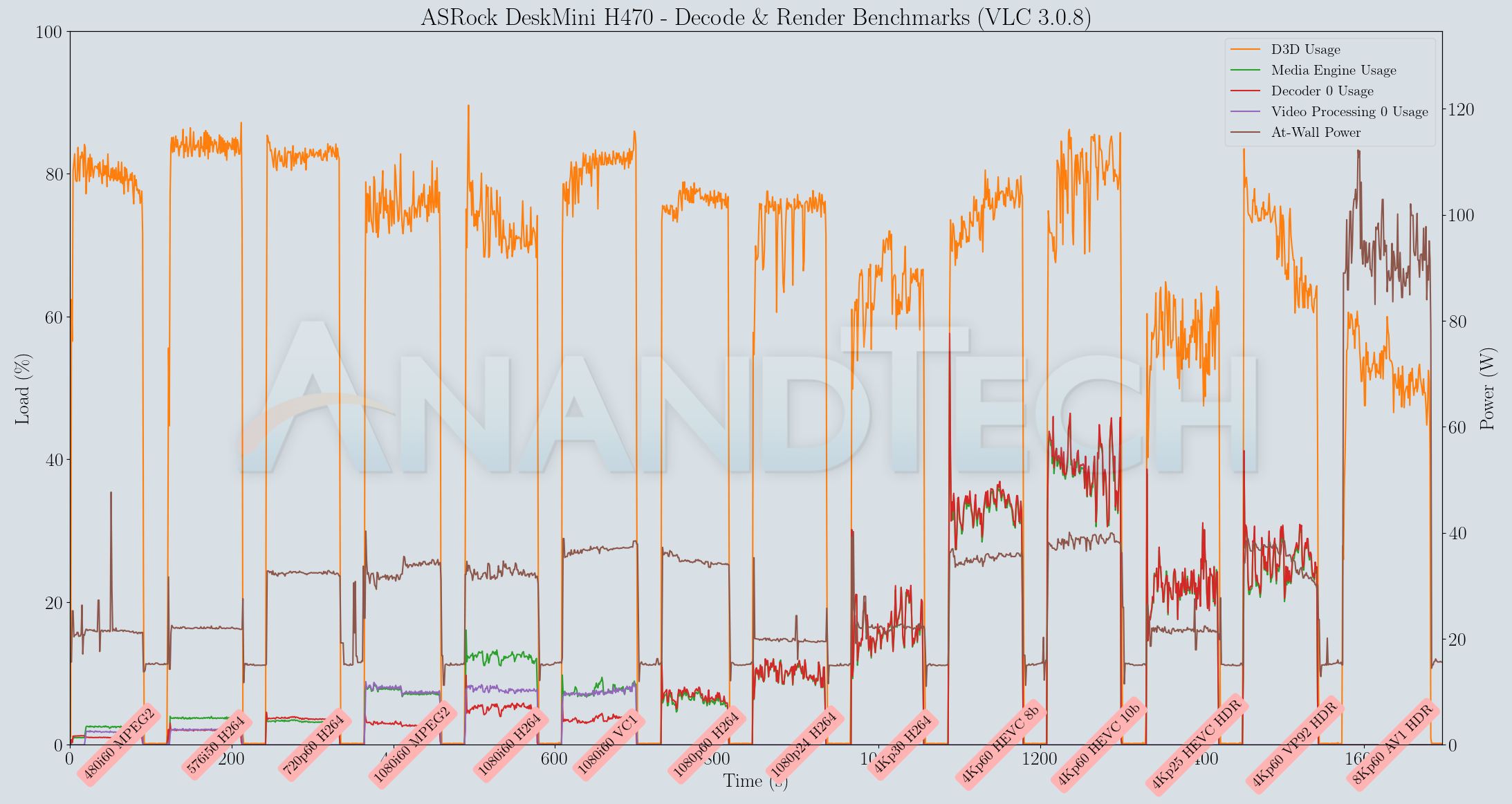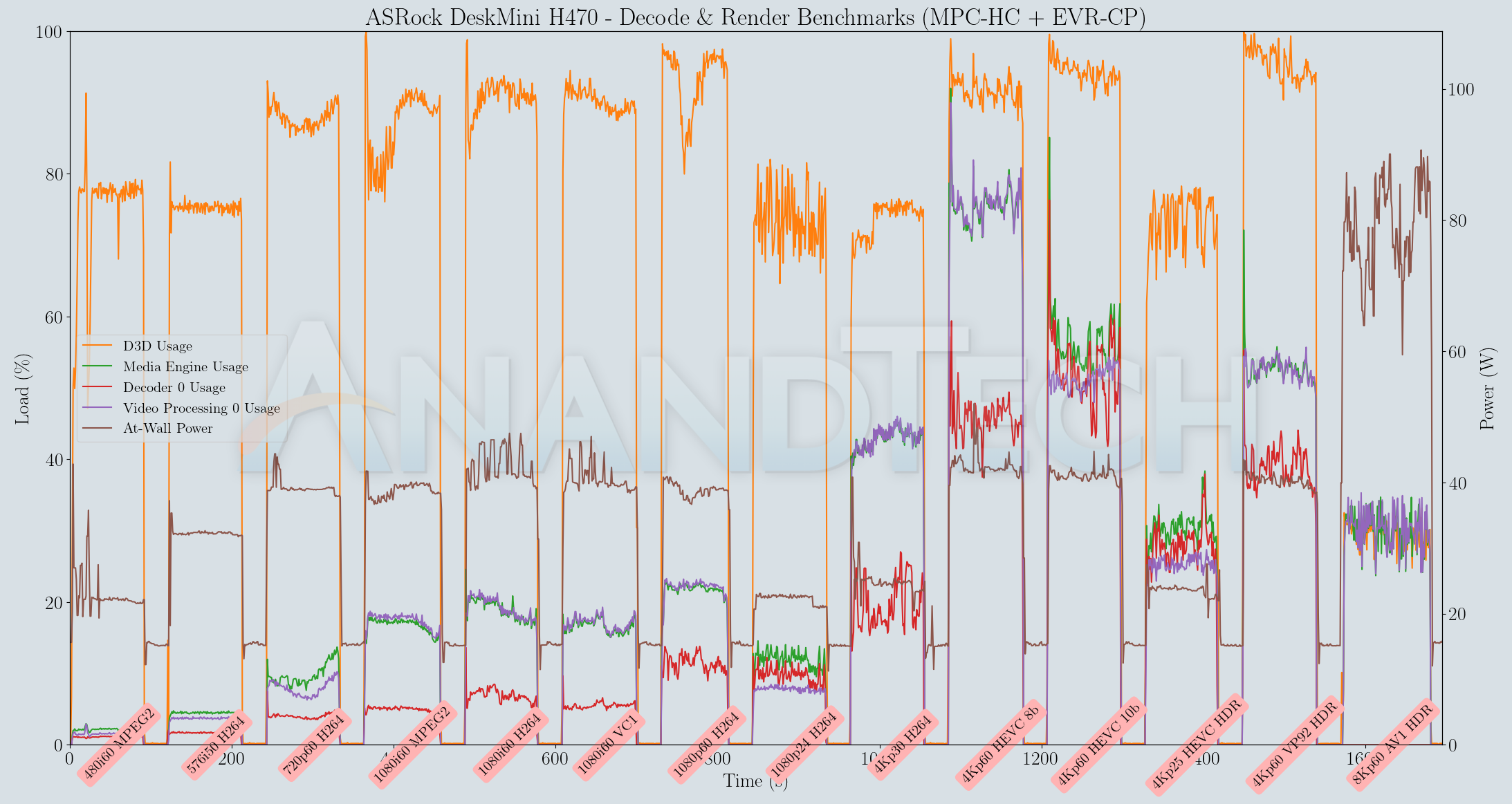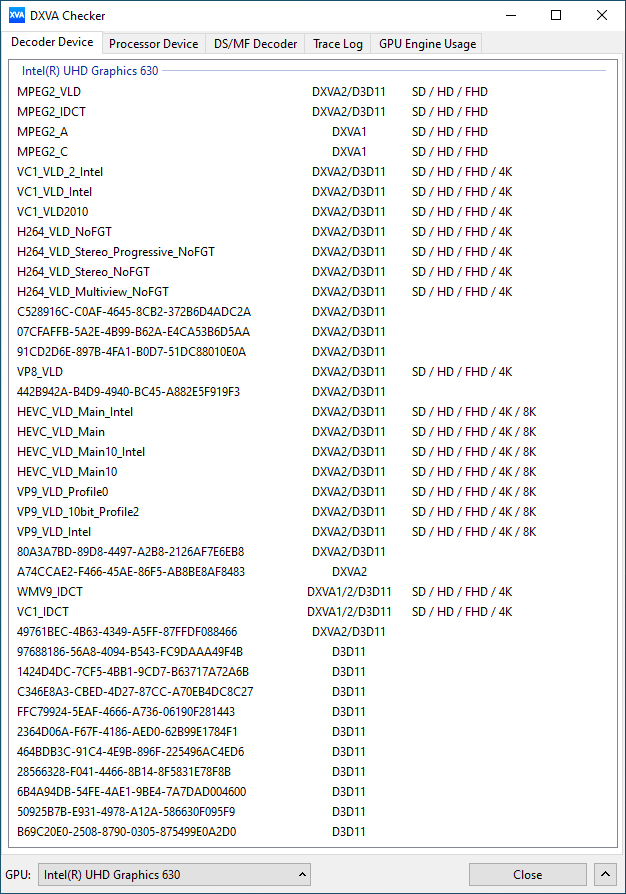ASRock DeskMini H470 Review: A No-Frills LGA 1200 mini-PC Platform
by Ganesh T S on December 29, 2020 8:00 AM ESTHTPC Credentials - Local Media Playback and Video Processing
Evaluation of local media playback and video processing is done by playing back files encompassing a range of relevant codecs, containers, resolutions, and frame rates. A note of the efficiency is also made by tracking GPU usage and power consumption of the system at the wall. Users have their own preference for the playback software / decoder / renderer, and our aim is to have numbers representative of commonly encountered scenarios. Towards this, we played back the test streams using the following combinations:
- MPC-HC x64 1.8.5 + LAV Video Decoder (DXVA2 Native) + Enhanced Video Renderer - Custom Presenter (EVR-CP)
- MPC-HC x64 1.8.5 + LAV Video Decoder (D3D11) + madVR 0.92.17 (DXVA-Focused)
- VLC 3.0.8
- Kodi 18.9
Fourteen test streams comprising of various codecs and frame rates (each of 90s duration) were played back from the local disk with an interval of 30 seconds in-between. Various metrics including GPU usage and at-wall power consumption were recorded during the course of this playback. Prior to looking at the metrics, a quick summary of the decoding capabilities of the GPU is useful to have for context.
Other than for AV1, the Intel UHD Graphics 630 in Comet Lake-S processors such as the Core i7-10700 should have no trouble activating hardware acceleration for various commonly-used video codecs.
All our playback tests were done with the desktop HDR setting turned on. It is possible for certain system configurations to have madVR automatically turn on/off the HDR capabilities prior to the playback of a HDR video, but, we didn't take advantage of that in our testing.
VLC and Kodi
VLC is the playback software of choice for the average PC user who doesn't need a ten-foot UI. Its install-and-play simplicity has made it extremely popular. Over the years, the software has gained the ability to take advantage of various hardware acceleration options. Kodi, on the other hand, has a ten-foot UI making it the perfect open-source software for dedicated HTPCs. Support for add-ons make it very extensible and capable of customization. We played back our test files using the default VLC and Kodi configurations, and recorded the following metrics.
| Video Playback Efficiency - VLC and Kodi | |||

The resource usage profiles for both VLC and Kodi are quite similar, with the Kodi playback making additional usage of the video processor block in the GPU. However, in terms of power consumption at the wall, both programs stay south of 40W for almost all of the hardware-accelerated codec streams. The AV1 stream plays back in software-decode mode as a bunch of still frames and the collected metrics corresponding to that can be ignored.
MPC-HC
MPC-HC offers an easy way to test out different combinations of decoders and renderers. The first configuration we evaluated is the default post-install scenario, with only the in-built LAV Video Decoder forced to DXVA2 Native mode. Additional passes were done with different madVR configurations, but we only present results from the DXVA-focused one. The metrics collected during the playback of the test files using the above two configurations are presented below.
| Video Playback Efficiency - MPC-HC with EVR-CP and madVR | ||

In both MPC-HC modes, the system has no trouble playing back the streams without apparent dropped frames. However, the 60fps clips are too close to consuming 100% of the D3D resources.
In terms of HTPC capabilities, both Kodi and VLC are capable of showcasing the video playback capabilities of the DeskMini H470 in an effective manner.











26 Comments
View All Comments
Tomatotech - Tuesday, December 29, 2020 - link
That’s possibly one of the best possible arrangements for the m.2 slot then as the metal tray will be an excellent heat sink. You could even add a bit of thermally conductive foam (make sure it’s not the electrically conductive type) to help with heat transfer to the tray.ganeshts - Tuesday, December 29, 2020 - link
The Ultra M.2 slot is on the top side of the board. That is the one used with Comet Lake CPUs. The slot you are referring to is the Hyper M.2 (PCIe 4.0 x4) slot which is usable only when the Rocket Lake CPUs come around.twotwotwo - Tuesday, December 29, 2020 - link
Its AMD relative the A300 was my main machine for a while, and had it been easier to get Zen 2 desktop APUs I might still be using it. Quiet (given a decent fan), cheap, tiny (obvs), reasonably expandable, gets the job done--about all I can ask for from a work desktop.Death666Angel - Tuesday, December 29, 2020 - link
The 4000 Series Pro APUs are pretty well available in Germany, from reputable online retailers. I can get the R5 Pro 4650G for 20% more than the equivalent R5 3600 (200€ vs 240€ roughly). That would be my sweet spot, personally. For 8 cores it's also roughly 20% (280€ vs 340€) but for that price difference, you could get a nice used GPU already that will maybe game better. I personally could never justify a GPU-less build, although I am eternally curious about them and plot one out once every couple of months.... and then I look at benchmarks of dGPU vs iGPU and stop. :DTomatotech - Tuesday, December 29, 2020 - link
I didn’t see it in the article so here are the specs:155 x 155 x 80 mm (1.92L)
Not bad, though for most low to mid-level use cases it’d be far cheaper to buy a used Lenovo or Dell USFF PC - these have even less volume at around 1.1L but are slightly larger and flatter (around 180x180x35mm)
For SFF with GPU I still prefer something like the K39 mITX chassis on the low end which comes in at 3L but allows you to use most full-sized GPUs (but for now possibly not the nVidia 3000 series).
Samus - Tuesday, December 29, 2020 - link
I've been rocking the FT03-Mini and while it is an absolute nightmare to work inside of (and I question my sanity for why I put myself through owning it) it is still a very effective ITX chassis for the size, capable of 10.5" videocards, multiple hard drives (plus two m2 drives you can mount to most current motherboards) while using a single 140mm fan to cool everything. Realistically the highest TDP CPU you want to use is around 88-watts as anything more you will stress any closed loop cooler with a 25mm radiator (the max the case can accept) and need to go to a heatsink of some sort with another dedicated fan.Obrut - Tuesday, December 29, 2020 - link
It will be interesting to see a comparison with ASRock Jupiter H470, which has a much different form factor and cooling solution.M O B - Tuesday, December 29, 2020 - link
I have a Deskmini 310w--is the UHD 630 on 10th gen CPUs any faster than the UHD 630 on older CPUs?If not, then it seems like this iteration basically adds some USB 3.0 ports versus my current build.
ganeshts - Wednesday, December 30, 2020 - link
I think the additional angle here is that of a low-cost platform that can take advantage of the RKL-S CPUs coming in 2021. Personally, I also think it is not a great choice to upgrade for those who already have the 310. It is meant more for folks getting their first mSTX machine.Samus - Tuesday, December 29, 2020 - link
I had the SST-AR11 cooler in my Silverstone FT03-Mini and was pretty disappointed (partially due to the chassis inherently poor ventilation) and equally disappointed by closed-loop coolers due to the 25mm thickness limitation of radiators. After spending seemingly hundreds of dollars and way too much time hunting for a thermal solution, some forum posts directed me to try the NT06-Pro, which would theoretically fit this mSTX chassis as long as there is no interference with the power supply.It performs incredible well as you position the fan under the fins and blow the heat away from the motherboard instead of onto it, giving it somewhat of the beneficial effect of a tower-style cooler.